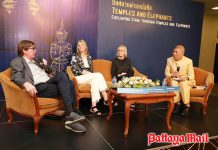
Los Angeles (AP) – With hollow eyes and sagging cheeks, the flabby white mask of Michael Myers is horror’s great blank slate. Project your fears here, it says. Myers doesn’t speak. His movements never rise beyond a deliberate gait (well, aside from all the stabbing and strangling). Even his name is purposefully bland.
Decades after John Carpenter’s slasher landmark, David Gordon Green has resurrected the faceless Boogeyman of “Halloween” and set him loose on another Halloween night, 40 years later. Time has done little for Michael’s personality. He is still a poor conversationalist. (He hasn’t uttered a word in the intervening decades, says a doctor at the sanatorium that holds him.) He is still handy with a knife.
There are no roman numerals in the title of Green’s film, nor any of those dopey subtitles like 1998’s “Halloween H20,” which presumably delved into the very real fears of dehydration. As if to draw closer to the original (and to ignore the nine sequels and reboots in between), this “Halloween” has simply taken Carpenter’s 1978 title. And with gliding cameras, Carpenter’s score and original cast members Jamie Lee Curtis and Nick Castle (the man under the mask), it has tried very hard to take much more, too.
But while Green’s “Halloween,” which he penned with Danny McBride and Jeff Fradley, has faithfully adopted much of what so resonated in Carpenter’s genre-creating film — the stoic killer, the gruesome executions, the suburban nightmares — what makes his “Halloween” such a thrill is how it deviates from its long-ago predecessor.
Setting the template for countless slashers to follow, Carpenter’s film often reserved its most painful endings for more promiscuous girls or drug-using teens. As a grim reaper carrying out a metaphorical reckoning, Michael had questionable biases.
But what Carpenter did do was equate sex with violence, a connection that Green has elaborated on with a more feminist streak. Having survived the “Babysitter Murders” of 40 years ago, Laurie Strode (a fabulously fierce Jamie Lee Curtis, reprising the role that was her film debut) is now a self-described “twice-divorced basket case” living in a run-down house on the outskirts of the fictional Haddonfield, Illinois. She has turned her home into a training ground and domestic fortification (beneath the kitchen island is a well-armed shelter) for the second coming of Michael she’s always been sure will happen.
Her daughter (Judy Greer) and her son-in-law (Toby Huss) have grown tired of Strode’s fanatical survivalist paranoia. Certain that the world isn’t so bad a place as Strode insists, they plead for her to get over it. Their high-school daughter, Allyson (Andi Matichak) isn’t so sure, and she naturally gravitates to the grandmother she’s been shielded from.
The curiosity of “Serial”-like podcast journalists (Jefferson Hall, Rhian Rees) introduces us to both the locked-up Myers and the withdrawn Strode. Before curtly dismissing them, Strode insists their investigation into Myers is pointless. “There’s nothing to learn,” says Strode, surely no fan of, say, neo-Nazi newspaper features. Hunt evil, she believes, don’t analyze it. It’s a message peppered throughout “Halloween” with clear reference to today (and to some of the earlier “Halloween” installments that sought to understand Michael).
Needless to say, both those who dismiss Strode’s deep-seated trauma and those who would rather study evil than confront it are gonna get their comeuppance. When Michael is transferred to another facility, hell predictably breaks loose. Once Michael is again stalking the suburban streets of Haddonfield, custom kitchens start seeing their cutlery disappear, and the shadows and closets of seemingly safe neighborhoods are again rife with danger. Evil — soulless and unkillable — lurks everywhere, even if does wear a silly mask.
Green, the sometimes brilliant, sometimes confounding filmmaker of art-house indies (“George Washington”), broader comedies (“Pineapple Express”) and, more recently, a few starry studio projects (“Our Brand Is Crisis”), can’t recreate the eeriness of Carpenter’s original. But he pumps more blood into the story, both literally and figuratively. Foggy nights and gas-station bathrooms turn predictably gory, more so than the original. But the scenes that fall between those foreboding, twinkling piano notes have far more warmth and spirit than you’d expect. You almost wish Green — easily the most talented filmmaker in the franchise since Carpenter — was instead making something original here on the same streets, with the same cast (including the scene-stealing Miles Robbins) and none of the skull crushing.
But there are rituals to observe, and this “Halloween” lives up to its name.
“Halloween,” a Universal Pictures release, is rated R by the Motion Picture Association of America for horror violence and bloody images, language, brief drug use and nudity. Running time: 105 minutes. Three stars out of four.




